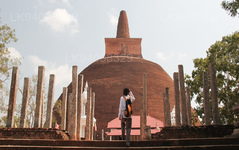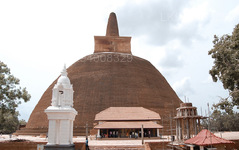
Anuradhapura by
Anuradhapura tilhører den nordlige sentrale provinsen på Sri Lanka. Anuradhapura er en av de gamle hovedstedene på Sri Lanka, kjent for sine godt bevarte ruiner av den gamle lankiske sivilisasjonen. Byen, som nå er et UNESCOs verdensarvsted, ligger 205 km nord for den nåværende hovedstaden Colombo på Sri Lanka.
Abhayagiri Dagoba
Abhayagiri Vihāra was a major monastery site of Mahayana, Theravada and Vajrayana Buddhism that was situated in Anuradhapura, Sri Lanka. It is one of the most extensive ruins in the world and one of the most sacred Buddhist pilgrimage cities in the nation. Historically it was a great monastic centre as well as a royal capital, with magnificent monasteries rising to many stories, roofed with gilt bronze or tiles of burnt clay glazed in brilliant colors. To the north of the city, encircled by great walls and containing elaborate bathing ponds, carved balustrades and moonstones, stood "Abhayagiri", one of seventeen such religious units in Anuradhapura and the largest of its five major viharas. One of the focal points of the complex is an ancient stupa, the Abhayagiri Dagaba. Surrounding the humped dagaba, Abhayagiri Vihara was a seat of the Northern Monastery, or Uttara Vihara and the original custodian of the Tooth relic in the island.
The term "Abhayagiri Vihara" refers not only to the complex of monastic buildings, but also a fraternity of Buddhist monks, or Sangha, which maintained its own historical records, traditions and way of life. Founded in the 2nd century BC, it had grown into an international institution by the 1st century AD, attracting scholars from all over the world and encompassing all shades of Buddhist philosophy. Its influence can be traced to other parts of the world, through branches established elsewhere. Thus, the Abhayagiri Vihara developed as a great institution vis‑a‑vis the Mahavihara and the Jetavana Buddhist monastic sects in the ancient Sri Lankan capital of Anuradhapura.
It is recorded in the chronicle that Abhayagiri Dagaba was established by King Valagamba during the period of his second reign, from 89-77 B.C.E. A young Brahmin named Tiya (Tissa) declared war against him. Tiya was deluded by the prophecy of another Brahmin that was destined to be king. Before the arrival of Bhikkhu Mahinda, who brought Buddhism to the island, Brahmins held the highest place in society. After the establishment of the Buddhist sangha on the island, however, they lost their supremacy, and were replaced by the sangha. Some Brahmins converted to Buddhism, while others revolted. Tiya, who enjoyed the support of his community, lived both in and outside of Sri Lanka, and was therefore very powerful.
Om Nord-Sentralprovinsen
Anuradhapura tilhører den nordlige sentrale provinsen på Sri Lanka. Anuradhapura er en av de gamle hovedstedene på Sri Lanka, kjent for sine godt bevarte ruiner av den gamle lankesiske sivilisasjonen. Byen, som nå er på UNESCOs verdensarvliste, ligger 205 km nord for den nåværende hovedstaden Colombo på Sri Lanka. I den hellige byen Anuradhapura og i nærheten finnes et stort antall ruiner. Ruinene består av tre typer bygninger: dagobas, klosterbygninger og pokuna (dammer). Byen hadde noen av de mest komplekse vanningsanleggene i den antikke verden, og ligger i den tørre sonen av landet. Administrasjonen bygde mange tanker for å vanne landet. De fleste sivile er singalesere, mens tamiler og srilankiske maurere bor i distriktet.
Om Nord-Sentralprovinsen
Nord-Sentral-provinsen, som er den største provinsen i landet, dekker 16 % av landets totale landareal. Nord-Sentral-provinsen består av to distrikter kalt Polonnaruwa og Anuradhapure. Anuradhapura er det største distriktet på Sri Lanka. Arealet er 7 128 km². Nord-Sentral-provinsen har en rekke potensialer for investorer som vil starte sine virksomheter, spesielt landbruk, landbruksbaserte næringer og husdyrsektoren. Mer enn 65 % av befolkningen i Nord-Sentral-provinsen er avhengige av grunnleggende landbruk og landbruksbaserte næringer. NCP kalles også «Wew Bendi Rajje» fordi det finnes mer enn 3000 mellomstore og store dammer i provinsen. Sri maha bodiya, Ruwanweli seya, Thuparama dageba, Abayagiri-klosteret, Polonnaruwa Rankot wehera og Lankathilake er redde.














